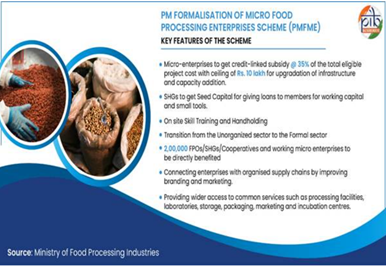

8th September 2025 (12 Topics)
Context:
As of June 2025, ?3,791.1 crore has been released to States/UTs, with over 1.44 lakh loans sanctioned under the PMFME scheme, reflecting progress in formalising India’s micro food processing sector.
“Vocal for Local”: Building Competitiveness in Food Processing
Introduction
- Launched on 29 June 2020, PMFME is a Centrally Sponsored Scheme under the Atmanirbhar Bharat Abhiyaan.
- Total outlay: ?10,000 crore (2020–21 to 2025–26) with cost-sharing (Centre–State 60:40; 90:10 for NE/Himalayan States; 100% for UTs without legislature).
- Aims: formalisation of 2 lakh micro food units, adoption of ODOP (One District One Product) approach, and strengthening infrastructure.
Key Components of the Scheme
- Support for Individual Units
- Credit-linked subsidy: 35% of project cost (ceiling ?10 lakh).
- Beneficiary contribution: 10%; balance via bank loan.
- Support for Groups (FPOs/Cooperatives/SHGs)
- Seed capital: ?40,000 per SHG member for working capital and tools.
- Grant support at 35% for FPOs and cooperatives.
- Branding & marketing assistance for ODOP products at state/regional level.

- Common Infrastructure
- Facilities for grading, warehousing, cold storage, processing units, incubation centres.
- Promotes shared facilities for clusters under ODOP.
- Capacity Building
- Training and R&D support by NIFTEM, IIFPT, ICAR institutes, CSIR labs.
- Focus on technology adoption, entrepreneurship, and product-specific improvements.
Achievements (As of June 2025)
- ?11,501.79 crore loans sanctioned under credit-linked subsidy (1.44 lakh units).
- Seed capital support for 1.03 lakh SHG members worth ?376.98 crore.
- 93 common infrastructure projects sanctioned (?187.20 crore).
- 27 branding and marketing projects approved (?82.82 crore).
- 16 lakh beneficiaries trained in modern practices.
- Food processing exports:USD 49.4 billion (2024–25), with processed foods forming 4% of the share.
Analysis
- Economic Impact
- Strengthens linkages between agriculture and industry, creating rural jobs and reducing post-harvest losses.
- Expands India’s processed food exports, contributing to forex earnings.
- Social Impact
- Promotes women empowerment through SHGs.
- Supports traditional foods under ODOP, preserving cultural identity while improving market access.
- Institutional Impact
- Brings informal enterprises into the formal regulatory and credit system.
- Enhances skills and innovation via training institutes and incubation centres.
Challenges
- Low awareness among rural entrepreneurs and SHGs.
- Credit access difficulties despite subsidies, especially for first-generation entrepreneurs.
- Logistical gaps in cold chains and last-mile connectivity.
- Quality certification and standardisation remain weak for small producers.
Way Forward
- Awareness Campaigns: Strengthen outreach in rural areas with digital platforms and grassroots mobilisation.
- Ease of Credit: Simplify bank procedures, expand microfinance and fintech involvement.
- Market Linkages: Tie-ups with e-commerce, retail chains, and export councils to boost ODOP visibility.
- Quality Assurance: Provide standardisation and certification facilities at district level.
- Sustainability Integration: Encourage eco-friendly packaging, renewable energy use in processing units.
More Articles


